| ID |
Date |
Author |
Category |
Subject |
Year |
|
208
|
Sun Mar 22 23:19:23 2020 |
Michael | General | ESR Vacuum readings | |
|
| Attachment 1: ESR_Vakuum2020-03-22-2318.PNG
|
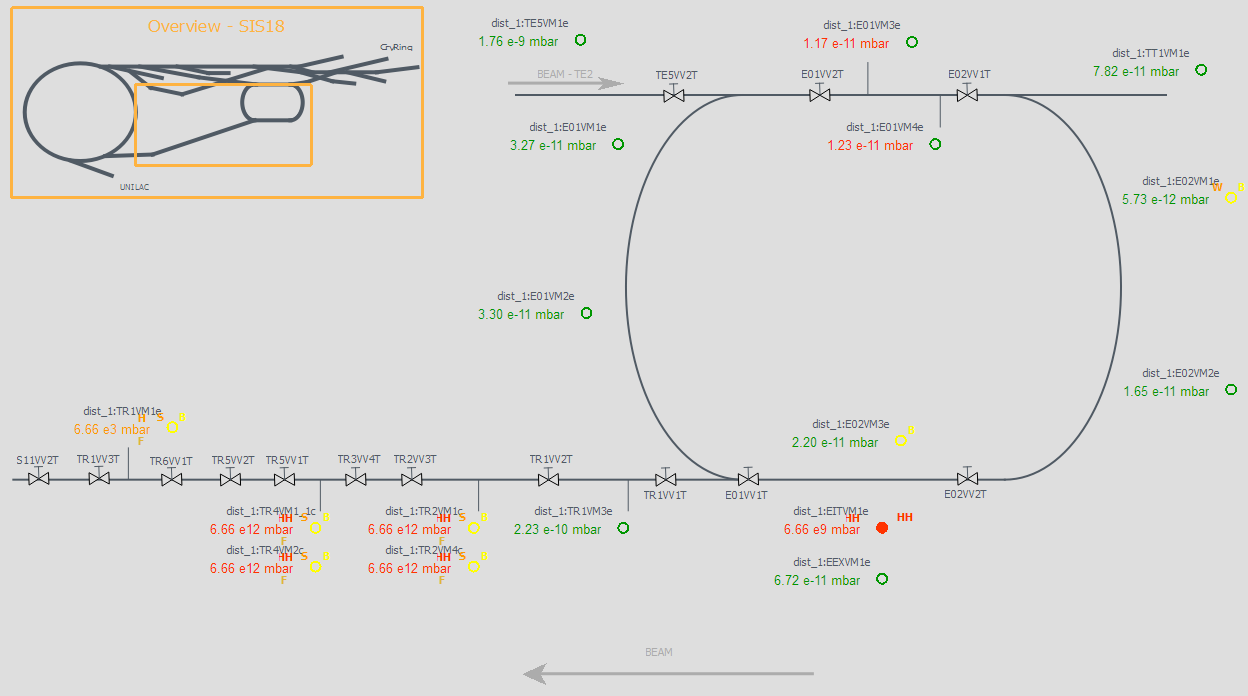
|
|
569
|
Mon May 31 10:08:42 2021 |
Jan, Sophia | Runs | E127b runsheet | 2021 |
|
| Attachment 1: e127b_runsheet.ods
|
|
249
|
Mon Mar 23 14:12:54 2020 |
Ragan | Runs | E127 experiment stops | |
close file : run104 (14:12:44)
E127 experiment finishes on a successful note )) Congratulations to the entire team !! |
|
282
|
Tue May 19 16:48:15 2020 |
Laszlo | General | E127 beamtime overview | |
Here is a representation how was the time management during E127. The time, what we could spend with measuring the 118Te(pg), was ~20% comparing to the given 6days. |
| Attachment 1: E127_beamtime_overview.png
|
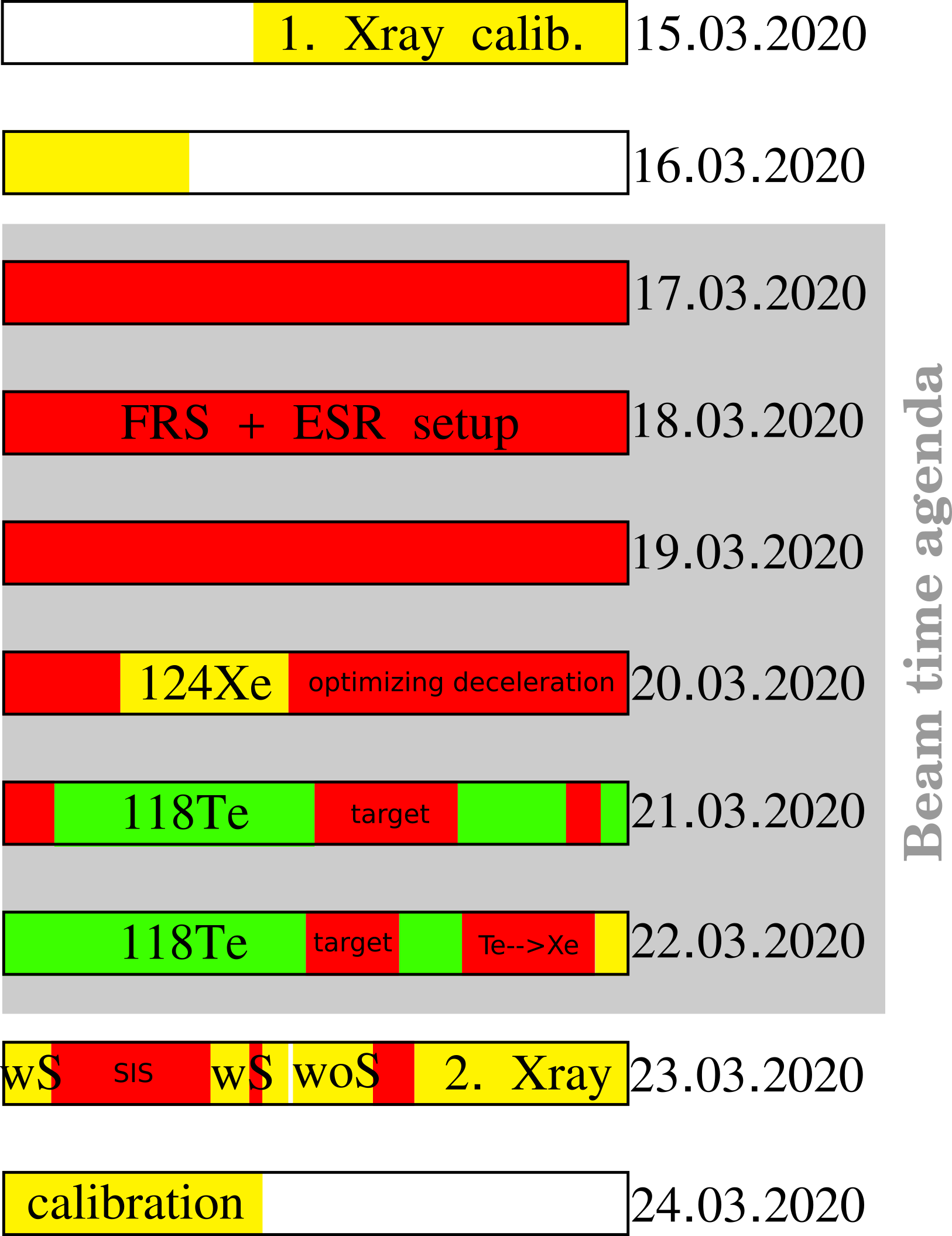
|
| Attachment 2: E127_beamtime_overview.pdf
|

|
|
29
|
Fri Nov 15 10:46:12 2019 |
Laszlo | Detectors | Detector movement from HKR | |
To move the detector remotely from the HKR:
-go to a desktop of a HKR computer
-right click: "App Launcher PRO"
(-you have to give some password at this point?)
-within the program go to "Development->ProHelper"
-write the name of our slow control unit in the field Nomen: "GE01DD4AS"
-There are 4rows, the middle two called: "Read props", "Write props"
-In "Read props" open "rposiabss" -> if you hit here the refresh button it will show only the SET position
-In "Read props" open "rposiabsi" -> if you hit here the refresh button it will show the REAL-TIME position of the detector
-In "Write props" open "wposiabss" -> here you can set the absolute position of our detector (one click is already enough to execute the command).
most OUT of the ring position: -10613 [0.1mm] in absolute
most IN into the ring position: -7 [0.1mm] in absolute
The value can have as big step size as we want contrary to relative movement, when you are limited to something like 20cm.
To close the program just simply hit the "x" buttons. |
| Attachment 1: IMG_20191114_135600.jpg
|
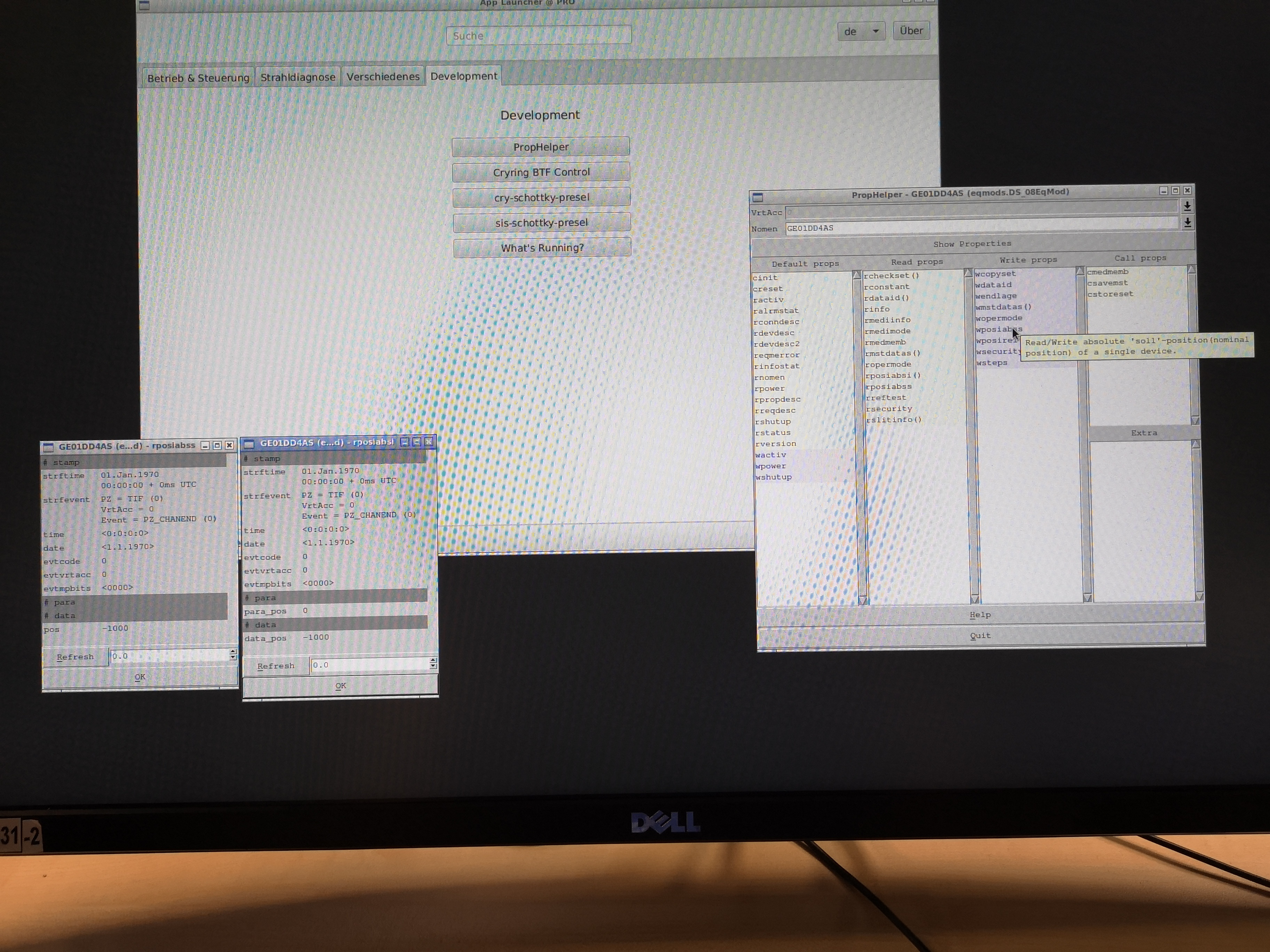
|
|
106
|
Sat Mar 21 06:02:22 2020 |
Tino, Oliver | General | Detector filling | |
Run stopped for detector fillings |
|
478
|
Wed May 26 20:34:50 2021 |
Ragan, Thanassis | Detectors | Detector filling | 2021 |
Jan is filling the detector after run0137. |
|
37
|
Tue Mar 10 08:52:34 2020 |
Jan | Detectors | DSSSD positioning | |
To find a good Si position, we need to follow a procedure similar to this:
1. Si in max-in position
2. find distance of beam by scraping with detector from inside
--> zero position
3. from this zero, we need to set a distance of about 1.5 cm to the inside (as shown in the sketch below)
It is likely that this position is not compatible with the complete ESR cycle (e.g. we scrape beam with det. during deceleration).
The solution is to move the beam closer to the detector after deceleration. There are two feasible methods to do this:
A. make a local bump in the dipole
--> check new zero and det. position again, as sketched above
--> in 2016 this method didn't allow to go close enough to the detector, eventually we used:
B. global orbit change (by magnet ramp) + target bump (to keep overlap)
--> this takes a bit more time to set up and also the cycle will be longer at low energies (critical due to life-time)
--> method A is preferred, but might not be strong enough
This needs to be checked and repeated for each new beam setting. |
| Attachment 1: optimum_detector_position_2.jpg
|
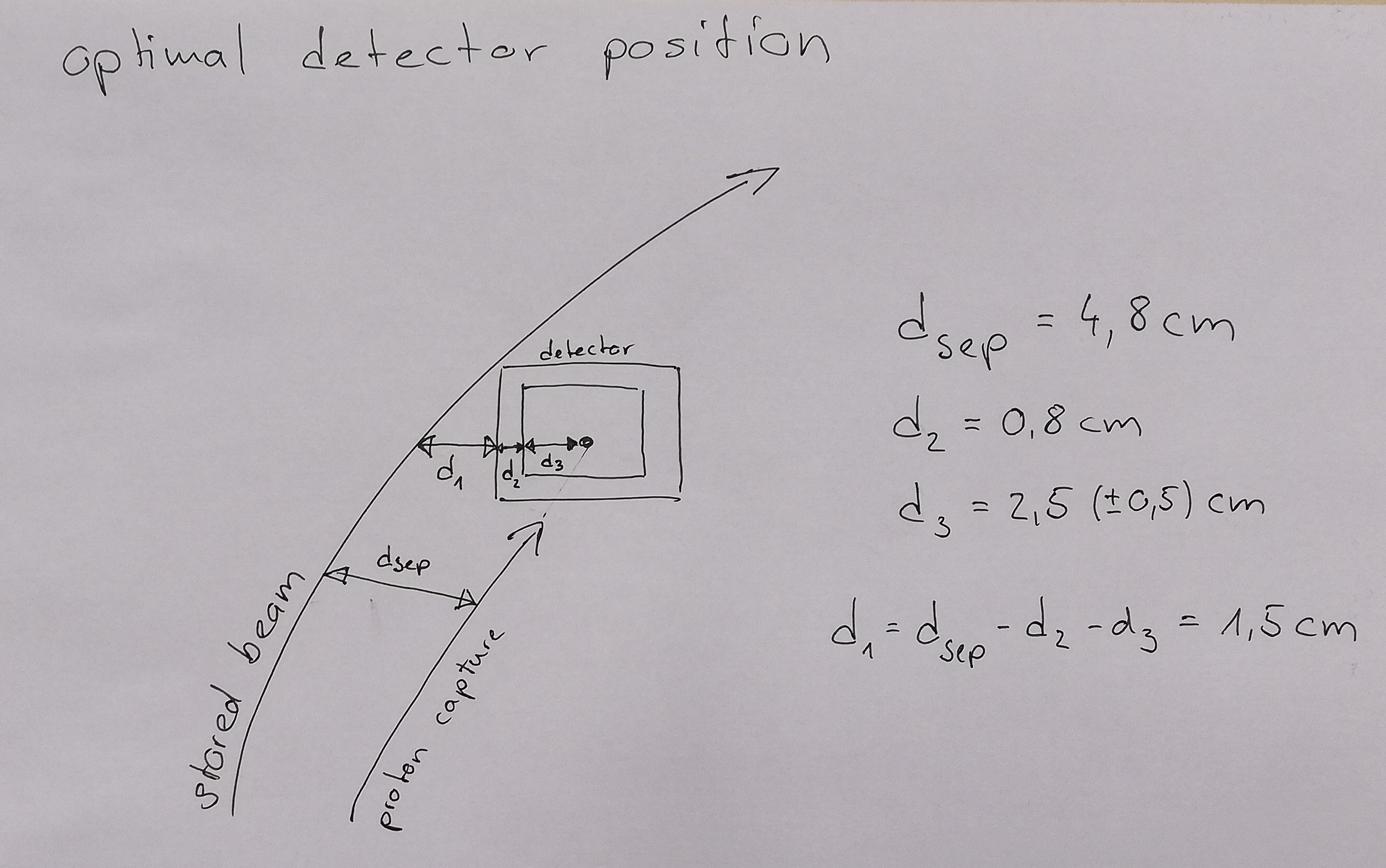
|
|
387
|
Sat May 22 16:28:10 2021 |
Laszlo | General | DSSSD movement | 2021 |
The DSSSD is moved back to its measurement position(-25mm). |
|
283
|
Fri Jun 5 14:06:15 2020 |
Laszlo | Detectors | DSSSD and SCRAPER position estimate for Xe and Te experiments | 2020 |
We don't know the exact absolute positions of the detector (+scraper) and the beam. However, what we have to know is only these two relative positions respect to each other. To get this distance I use two methods:
1, combining the infos from the set position during the beamtime + the measured pg peak position on the detector. The pg peak position is defined only by the eye (because of the low number of counts in every case, it doesnt make much sense to make fits). Since we rely on the detector resolution, we would be never more accurate than ~ +/-1.5mm anyhow. The active area of the detector is 49.5x49.5mm2 with a 45° tilt in y.
2, MOCADI simulation of the beam and the pg peak. This is used only as a crosscheck.
3, The scraper had a small angle in y direction causing ~0.5cm shift to the upper direction. the length of the scraping edge is 7cm
-124Xe with scraper measurement:
- measurement
d1 = moved back from beam = 15 +/-.5 mm
d2 = DSSSD frame width = 8.85 mm
d3 = pg center on DSSSD = 7-7.5 bin = 21.7-23.2 mm = avg = 22.5 mm
--> pg from beam in x = -46.4mm +/- 1.5mm
--> pg on DSSSD from center ~ -3.28mm +/- 1.5mm
- simulation
x = -46.5 mm
y = 0 mm
- detector active area position
x = (-73.35mm) - (-23.85mm)
y = (-14.2195mm) - 23.5125mm
- SCRAPING: x=-35mm +/-0.5mm away from beam
y=(-20mm) - (40mm)
-118Te:
- measurement
d1 = moved back from beam = 16 +/-.5 mm
d2 = DSSSD frame width = 8.85 mm
d3 = pg center on DSSSD = 7.5 bin = 23.2 mm
--> pg from beam in x = -48.05mm +/- 1.5mm
--> pg on DSSSD from center ~ -3.28mm +/- 1.5mm
- simulation
x = -48 mm
y = 0 mm
- detector active area position
x = (-74.35mm) - (-24.85mm)
y = (-14.2195mm) - 23.5125mm
- SCRAPING:
x=-35mm +/-0.5mm away from beam
y=(-20mm) - (40mm)
notes during beam-time:
https://elog.gsi.de/esr/E127/97?suppress=1 |
| Attachment 1: SP54120060514100.pdf
|
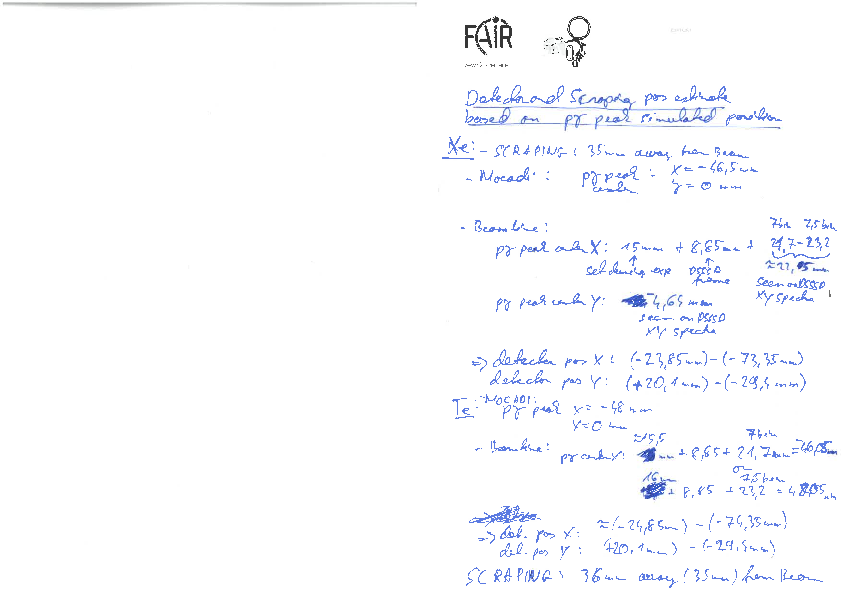
|
| Attachment 2: DSSSD_new1.pdf
|
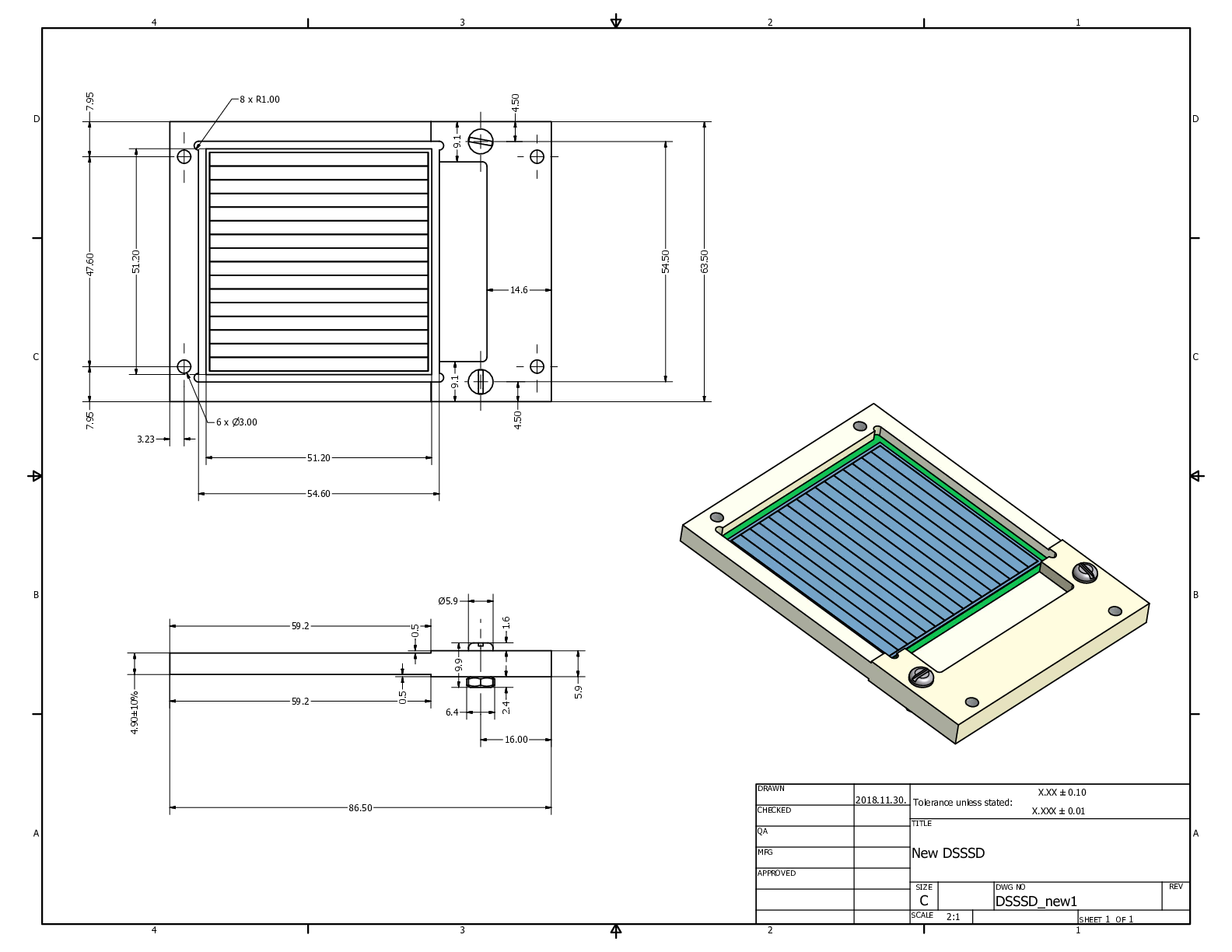
|
| Attachment 3: IMG_20200321_025644.jpg
|
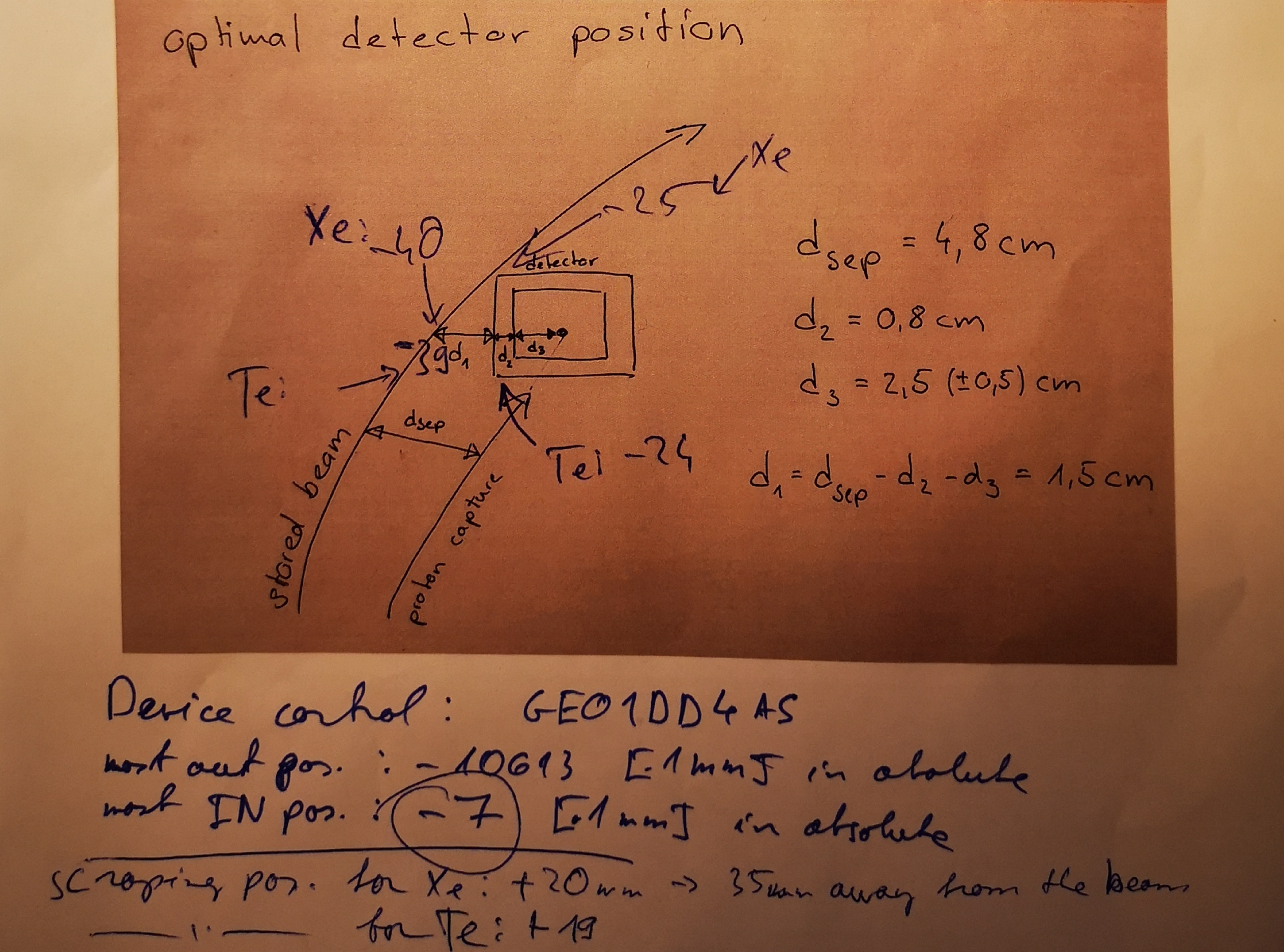
|
|
28
|
Wed Nov 6 14:13:53 2019 |
Jan, Laszlo | Detectors | DSSSD - 1st movement - realignment | |
We moved the new detector installation for the first time slowly into the dipole chamber.
The alignement seems to be pefect, no distortion or vertical movement of the detector-arm was observed from the window flange.
The vacuum on the detector side went up from 2e-10 mbar to about 5e-9 mbar.
On the ring side it was 3e-11 mbar befor and 1e-10 mbar after movement.
The extreme positions possible (Endlage) are:
max out: -10613
max in: -7
These are the absolute positions in units of 0.1 mm
It has to be noted that after bakeout a realignment of the detector was needed in order to have it centered in vertical dimension. However, this realignment has been only slight turns of the base flange alignment screws. In detail, the two inner "Sechskantschrauben" below the bellow have been loosed slightly, while the outer two have been tightend. Additionally, the small "Madenschraube" on the outside has been loosend by 1/4 turn.
In result the detector could be raised in vertical position by about ~5mm (jugded by eye).
The effect of small turning on the screws is extreme on the detector position! Be careful when re-adjusting. |
|
287
|
Tue Feb 2 13:59:00 2021 |
Jan | Detectors | DSSD installation and alignment | 2021 |
The DSSD has been exchanged and aligned in
November 2020. After bakeout at 140°C
(externally, 120°C at internal temp. Sensor)
for more than a week, the vacuum in the setup
is roughly 4.5e-10 mbar.
After the bakeout the detector had to be
realigned, it was lower by 1-2 mm. Using the
line laser the realignment was done by
touching only the screws on the far part of
the base of the flange. These screws have been
thightend by about a 1/4 turn after releasing
the headless positioning screw accordingly. |
|
286
|
Tue Nov 24 15:35:49 2020 |
Jan | Calibration | DSSD X/Y channel mapping | 2021 |
During the detector test test measurements with alpha source the allocation of the 16 X- and 16 Y-channels has been checked.
For the following final allocation, it is always assumed that the (horizontal) y-strips are placed to face the beam directly, while the (vertical) x-strips are on the backside.
Now, all cables from the preamp to the ADC/TDCs are either labeled BLACK (= X-strips, pos. signals) or labeled RED (= Y-strips, neg. signals). These red or black connections should be kept consistently in order to ensure a well known orientation of the DSSD during the experiment. The test run Si2_run006.lmd was taken with this final assignment and serves as reference.
BLACK LABEL > X1 to X16 > pos. MSCF > ADC/TDC ch 0-15 > 50 Ohm resistor at preamps HV-input
RED LABEL > Y1 to Y16 > neg. MSCF > ADC/TDC ch 16-31 > neg. bias voltage at preamps HV-input
Additionally, the RED label indicates the section on the preamp to which negative bias voltage should be applied. |
|
386
|
Sat May 22 14:53:34 2021 |
Beatriz et al. | General | DSSD Movement | 2021 |
DSSSD moved to the most in position in order to try to scrape the beam with the scraper. |
|
12
|
Fri Jun 7 15:57:41 2019 |
Jan | DAQ | DAQ with & without MDPP-16 | |
The DAQ located in
../esrdaq_2018/r4l-58/
currently includes the readout of
MADC
Caen 775 TDC
Caen 830 Scaler
MDPP-16
../esrdaq_2018/r4l-58_rewind/
is without the MDPP-16:
MADC
Caen 775 TDC
Caen 830 Scaler |
|
26
|
Wed Oct 23 15:35:29 2019 |
Jan | DAQ | DAQ with & without MDPP-16 | |
the DAQ located in
../esrdaq_2018/r4l-58_dev/
currently includes
2x MADC
2x Caen V775 TDC
2x Caen V830 Scaler
> The DAQ located in
>
> ../esrdaq_2018/r4l-58/
> currently includes the readout of
> MADC
> Caen 775 TDC
> Caen 830 Scaler
> MDPP-16
>
> ../esrdaq_2018/r4l-58_rewind/
> is without the MDPP-16:
> MADC
> Caen 775 TDC
> Caen 830 Scaler |
|
71
|
Fri Mar 20 04:29:45 2020 |
Jan | DAQ | DAQ settings for the first night | |
|
| Attachment 1: e127.trlo
|
// -*- C++ -*-
/// ************************
// SETUP FILE FOR
// E127 experiment at ESR 2020
/// ************************
/////////////////////////////////
// ADC GATES
si_stretch = 2000 ns;
si_delay = 0 ns;
target_stretch = 15000 ns;
target_delay = 5000 ns; //5000 ns;
master_delay = 800 ns;
//////////////////////////////////
/// DOWNSCALING by 2^n
// n=5 >> 32
// n=6 >> 64
// n=7 >> 128
// n=8 >> 256
// n=9 >> 512
// TARGET ON
si_red = 0;
xray_red = 0;
baf_red = 5;//5;
// TARGET OFF
si_red_OFF = 0;
xray_red_OFF = 0;
baf_red_OFF = 0;//5;
//////////////////////////////////
// INPUTS
si_y = ECL_IN(1);
si_x = ECL_IN(2);
xray1 = ECL_IN(3);
xray2 = ECL_IN(4);
xray3 = ECL_IN(5);
baf = ECL_IN(6);
// = ECL_IN(7);
// = ECL_IN(8);
// = ECL_IN(9);
// = ECL_IN(10);
// = ECL_IN(11);
trafo = ECL_IN(12);
I_cool = ECL_IN(13);
U_cool = ECL_IN(14);
jet_S1 = ECL_IN(15);
// = ECL_IN(16);
jet_on = LEMO_IN(1);
jet_off = LEMO_IN(2);
//////////////////////////////
// OUTPUTS
si_gate = GATE_DELAY(1);
target_gate = GATE_DELAY(3);
qdc_gate = GATE_DELAY(4);
master_trig = GATE_DELAY(2);
pico_a = si_gate;
pico_b = target_gate;
//////////////////////////////
// CONSTANTS
long_gate = 2000 ns;
short_gate = 650 ns;
SECTION(all)
{
FRONT_LED(1) = TRIMI_TDT;
SERIAL_TSTAMP_IN = SERIAL_TSTAMP_OUT;
SERIAL_TSTAMP_LATCH = ACCEPT_PULSE;
slew_counter_add = 0x1000000;
fast_busy_len = 1000 ns;
DEADTIME_IN(1) = TRIMI_TDT;
/////////////////////////////////////////////////////////////
//PULSER
// mega_clock
period(4) = 1 us; // needed by UDP reader
// TRIGGER 11 >> interval for scaler readouts
period(1) = 1000 ms;
/////////////////////////////////////////////////////////////
// TRIGGERS
// coinc window length
accept_window_len = 1950 ns;
// THESE ARE THE VULOM INPUTS (det. triggers)
// STRETCH THE TRIGGER SIGNAL LONGER THAN THE accept_window_len
lmu_restart_mode(1) = LEAD_IF_INACT | GATE_ENABLE;
lmu_stretch(1) = long_gate; // front-back coinc gate
trig_stretch(1) = long_gate;
trig_stretch(2) = long_gate;
trig_stretch(3) = long_gate;
trig_stretch(9) = long_gate;
trig_stretch(10) = long_gate;
trig_stretch(11) = long_gate;
// SET UP DELAYS TO MATCH THE TRIGGER SIGNALS
//trig_delay(1) = 800 ns;
//trig_delay(2) = 800 ns;
//trig_delay(3) = 1120 ns;
//trig_delay(9) = 800 ns;
//trig_delay(10) = 800 ns;
//trig_delay(11) = 800 ns;
// STANDARD IS MODE_LEADING_EDGE (trigger on the falling edge)
// MODE_WHEN_PRESENT: check, if a signal is on (e.g. SPILL ON)
//trig_delay_mode(1) = MODE_THIS | MODE_LEADING_EDGE;
// DOWNSCALING FACTORS
// THIS IS FOR GENERATED TPATS (so downscale tpat number with red==2^n)
trig_red(1) = si_red;
trig_red(2) = xray_red;
trig_red(3) = baf_red;
trig_red(9) = si_red_OFF;
trig_red(10) = xray_red_OFF;
trig_red(11) = baf_red_OFF;
// ONLY NEEDED FOR MULTI-EVENT MODE / NO NEED NOW
//multi_trigger = 1;
////////////////////////////////////////////////////
// LMU SETUP
// THIS IS THE LOGIC MATRIX.
// TRIG_LMU_OUT(n) with 'n' being the tpat.
// TRIG_LMU_AUX 1
// silicon x/y OR
LMU_IN(1) = si_x;
LMU_IN(2) = si_y;
LMU_OUT(1) = LMU_IN(1) or LMU_IN(2);
TRIG_LMU_AUX(1) = LMU_OUT(1);
// TRIG_LMU_AUX 2
// xray OR
all_or_mask(2) = xray1 | xray2 | xray3;
LMU_IN(3) = ALL_OR(2);
LMU_OUT(2) = LMU_IN(3);
TRIG_LMU_AUX(2) = ALL_OR(2);
// TRIG_LMU 3
// BaF OR
LMU_IN(4) = baf;
LMU_OUT(4) = LMU_IN(4);
// BaF single
TRIG_LMU_AUX(3) = LMU_OUT(4);
//
TRIG_PENDING[11] = PULSER(1);
// TARGET_ON flag is TRIG_LMU_AUX(4)
// TARGET_ON_TRIGGERS
TRIG_LMU_OUT(1) = TRIG_LMU_AUX(1) and TRIG_LMU_AUX(4); //Si_ON
TRIG_LMU_OUT(2) = TRIG_LMU_AUX(2) and TRIG_LMU_AUX(4); //Xray_ON
TRIG_LMU_OUT(3) = TRIG_LMU_AUX(3) and TRIG_LMU_AUX(4); //BaF_ON
TRIG_LMU_OUT(4) = TRIG_LMU_AUX(1) and TRIG_LMU_AUX(3) and TRIG_LMU_AUX(4); //BaF+Si_ON
//TRIG_LMU_OUT(4) = ;
//TRIG_LMU_OUT(5) = ;
//TRIG_LMU_OUT(6) = ;
//TRIG_LMU_OUT(7) = ;
//TRIG_LMU_OUT(8) = ;
// TARGET_OFF_TRIGGERS
TRIG_LMU_OUT(9) = TRIG_LMU_AUX(1) and not TRIG_LMU_AUX(4); //Si_OFF
TRIG_LMU_OUT(10) = TRIG_LMU_AUX(2) and not TRIG_LMU_AUX(4); //Xray_OFF
TRIG_LMU_OUT(11) = TRIG_LMU_AUX(3) and not TRIG_LMU_AUX(4); //BaF_OFF
//TRIG_LMU_OUT(12) = ;
//TRIG_LMU_OUT(13) = ;
//TRIG_LMU_OUT(14) = ;
//TRIG_LMU_OUT(15) = ;
TRIG_LMU_OUT(16) =
si_x and si_y and
xray1 and xray2 and xray3 and baf and
trafo and I_cool and U_cool and jet_S1;
////////////////////////////////////////////////////////////
// TPAT SETUP
// THIS IS FOR MATCHING: TPAT -> MBS_TRIGGER
// tpat_trig(n) = m
// with n = tpat, m = MBS_trigger
// MBS trigger 1 = JET_ON
tpat_trig(1) = 1;
tpat_trig(2) = 1;
tpat_trig(3) = 1;
tpat_trig(4) = 1;
tpat_trig(5) = 1;
tpat_trig(6) = 1;
tpat_trig(7) = 1;
tpat_trig(8) = 1;
// MBS_trigger 2 = JET_OFF
tpat_trig(9) = 2;
tpat_trig(10) = 2;
tpat_trig(11) = 2;
tpat_trig(12) = 2;
tpat_trig(13) = 2;
tpat_trig(14) = 2;
tpat_trig(15) = 2;
tpat_trig(16) = 2;
// THIS IS FOR ENABLING THE SINGLE TPATS
// WITH A MASK, OR THE TPATS, OR RANGES WITH n : m.
tpat_enable = 1:4, 9:11;
//tpat_enable = 9:11;
//tpat_enable = mask 0xffff;
///////////////////////////////////////////////////////
// GATE & DELAY (MAX=4)
// SET UP THE GATES AND DELAYS
// Silicon ADC gate
// si_gate
GATE_DELAY(1) = MASTER_START;
delay(1) = si_delay;
stretch(1) = si_stretch;
// Masterstart/trigger
// master_trig
GATE_DELAY(2) = MASTER_START;
delay(2) = master_delay;
stretch(2) = 200 ns;
// Xray/BaF ADC gate
// target_gate
GATE_DELAY(3) = MASTER_START;
delay(3) = target_delay;
stretch(3) = target_stretch;
//unused
GATE_DELAY(4) = MASTER_START;
delay(4) = 0 ns;
stretch(4) = 200 ns;
////////////////////////////////////////////////////////
// SIGNAL I/O
// MAP THE LEMO & ECL OUTS
LEMO_OUT(1) = master_trig;
LEMO_OUT(2) = master_trig;
ECL_OUT(1) = si_gate;
ECL_OUT(2) = si_gate;
ECL_OUT(3) = target_gate;
ECL_OUT(4) = target_gate;
ECL_OUT(5) = qdc_gate;
ECL_OUT(6) = qdc_gate;
ECL_OUT(7) = master_trig;
ECL_OUT(8) = master_trig;
ECL_OUT(9) = pico_a;
//ECL_OUT(10) = ;
ECL_OUT(11) = pico_b;
//ECL_OUT(12) = ;
//ECL_OUT(13) = ;
//ECL_OUT(14) = ;
//ECL_OUT(15) = TRIG_LMU_OUT(1);
//ECL_OUT(16) = LMU_OUT(1);
/* Generates internal BOS and EOS. */
/*
spill_period_duration = 20000000 us;
spill_on_duration = 12000000 us;
SECTION(bos_eos_generate)
{
period(3) = spill_period_duration;
GATE_DELAY(3) = PULSER(3);
stretch(3) = spill_on_duration;
delay(3) = 0 ns;
TRIG_PENDING[12] = PULSER(3);
GATE_DELAY(4) = GATE_DELAY(3);
stretch(4) = 50 ns;
delay(4) = 0 ns;
restart_mode(4) = TRAILING_EDGE;
TRIG_PENDING[13] = GATE_DELAY(4);
TRIG_LMU_AUX(3) = GATE_DELAY(3);
}
*/
/* Listens to BOS and EOS from the accelerator. */
////////////////////////////////////////////////////
// JET ON/OFF TRIGGER SETUP
EDGE_GATE_START(1) = jet_on;
TRIG_PENDING[12] = jet_on;
EDGE_GATE_STOP(1) = jet_off;
TRIG_PENDING[13] = jet_off;
TRIG_LMU_AUX(4) = EDGE_GATE(1);
}
|
| Attachment 2: main.cfg
|
#log_level = verbose
CRATE("Master")
{
event_max = 1
BARRIER
MESYTEC_MADC32(0x00A10000) {
nim_busy = gate0
range = 8 V
resolution=8
hires=true
}
BARRIER
MESYTEC_MADC32(0x00A20000) {
nim_busy = gate0
range = 4 V
resolution=8
hires=true
}
#BARRIER
#CAEN_V965 (0x00B10000) {
# channel_enable = 0..11
#}
BARRIER
CAEN_V775 (0x00C10000) {
common_start = false
time_range = 1200 ns
suppress_invalid = true
suppress_over_range = true
}
BARRIER
CAEN_V775 (0x00C20000) {
common_start = false
time_range = 1200 ns
suppress_invalid = true
suppress_over_range = true
}
BARRIER
#CAEN_V830 (0x00E10000) {
# resolution = 32
# }
#BARRIER
#CAEN_V830 (0x00E20000) {
# resolution = 32
#}
#BARRIER
GROUP("Timetamp")
GSI_VULOM(0x05000000) {
timestamp = true
}
}
|
| Attachment 3: r3bfuser.cfg
|
[r3bfuser]
# White Rabbit ID, =0 -> don't write MBS TO timestamp sub-event.
# Subevent 10/1: WR subsystem ID + timestamp
# wr_id = 0x100
# Save LOS/ROLU scalers/samplers every n:th spill, =0 -> don't read.
# Subevent 38/3800: ECL_IN scalers + pileup histogram
# Subevent 39/3900: trloii sampler data
do_beam_scalers = 1
# Save spill structure with 1/10s sized bins.
# do_spill_struct = 10
# Handle spill triggers 10..13 specially, >0 -> keep-alive grace period in s.
# period put to ~2 weeks, to enable long-term vulom scalers with targetOFF
do_spill_triggers = 1000000
# Save TPAT sub-event for every event
# Subevent 36/3600: trlo multi-event TPAT information
do_tpat = 1
# Save LMU scalers on spill triggers (10..13).
# Subevent 37/3700: lmu scalers (input, before / after DT & after reduction)
do_lmu_scalers = 1
# Send beam samplers and LMU scalers via UDP, !="" -> target host.
do_udp = "lxg1275.gsi.de"
|
| Attachment 4: setting.1584673412
|
1584673412
Fri Mar 20 04:03:32 CET 2020
e127pi:mrcc:mscf1:getGainCommon 1
e127pi:mrcc:mscf1:getShapingTimeCommon 1
e127pi:mrcc:mscf1:getThresholdCommon 2
e127pi:mrcc:mscf1:getPzCommon 100
e127pi:mrcc:mscf2:getGainCommon 1
e127pi:mrcc:mscf2:getShapingTimeCommon 1
e127pi:mrcc:mscf2:getThresholdCommon 2
e127pi:mrcc:mscf2:getPzCommon 100
e127pi:mrcc:mscf3:getGainCommon 6
e127pi:mrcc:mscf3:getShapingTimeCommon 3
e127pi:mrcc:mscf3:getThresholdCommon 1
e127pi:mrcc:mscf3:getPzCommon 38
e127pi:mrcc:mscf1:getGain1 4
e127pi:mrcc:mscf1:getGain2 4
e127pi:mrcc:mscf1:getGain3 4
e127pi:mrcc:mscf1:getGain4 4
e127pi:mrcc:mscf1:getShapingTime1 1
e127pi:mrcc:mscf1:getShapingTime2 1
e127pi:mrcc:mscf1:getShapingTime3 1
e127pi:mrcc:mscf1:getShapingTime4 1
e127pi:mrcc:mscf2:getGain1 9
e127pi:mrcc:mscf2:getGain2 4
e127pi:mrcc:mscf2:getGain3 8
e127pi:mrcc:mscf2:getGain4 8
e127pi:mrcc:mscf2:getShapingTime1 2
e127pi:mrcc:mscf2:getShapingTime2 2
e127pi:mrcc:mscf2:getShapingTime3 2
e127pi:mrcc:mscf2:getShapingTime4 2
e127pi:mrcc:mscf3:getGain1 15
e127pi:mrcc:mscf3:getGain2 0
e127pi:mrcc:mscf3:getGain3 15
e127pi:mrcc:mscf3:getGain4 10
e127pi:mrcc:mscf3:getShapingTime1 0
e127pi:mrcc:mscf3:getShapingTime2 0
e127pi:mrcc:mscf3:getShapingTime3 1
e127pi:mrcc:mscf3:getShapingTime4 1
e127pi:mrcc:mscf1:getThreshold1 4
e127pi:mrcc:mscf1:getThreshold2 4
e127pi:mrcc:mscf1:getThreshold3 4
e127pi:mrcc:mscf1:getThreshold4 1
e127pi:mrcc:mscf1:getThreshold5 4
e127pi:mrcc:mscf1:getThreshold6 4
e127pi:mrcc:mscf1:getThreshold7 4
e127pi:mrcc:mscf1:getThreshold8 4
e127pi:mrcc:mscf1:getThreshold9 4
e127pi:mrcc:mscf1:getThreshold10 5
e127pi:mrcc:mscf1:getThreshold11 5
e127pi:mrcc:mscf1:getThreshold12 5
e127pi:mrcc:mscf1:getThreshold13 3
e127pi:mrcc:mscf1:getThreshold14 4
e127pi:mrcc:mscf1:getThreshold15 5
e127pi:mrcc:mscf1:getThreshold16 5
e127pi:mrcc:mscf1:getPz1 128
e127pi:mrcc:mscf1:getPz2 128
e127pi:mrcc:mscf1:getPz3 128
e127pi:mrcc:mscf1:getPz4 128
e127pi:mrcc:mscf1:getPz5 128
e127pi:mrcc:mscf1:getPz6 128
e127pi:mrcc:mscf1:getPz7 128
e127pi:mrcc:mscf1:getPz8 128
e127pi:mrcc:mscf1:getPz9 128
e127pi:mrcc:mscf1:getPz10 128
e127pi:mrcc:mscf1:getPz11 128
e127pi:mrcc:mscf1:getPz12 128
e127pi:mrcc:mscf1:getPz13 128
e127pi:mrcc:mscf1:getPz14 128
e127pi:mrcc:mscf1:getPz15 128
e127pi:mrcc:mscf1:getPz16 128
e127pi:mrcc:mscf2:getThreshold1 255
e127pi:mrcc:mscf2:getThreshold2 255
e127pi:mrcc:mscf2:getThreshold3 0
e127pi:mrcc:mscf2:getThreshold4 255
e127pi:mrcc:mscf2:getThreshold5 255
e127pi:mrcc:mscf2:getThreshold6 255
e127pi:mrcc:mscf2:getThreshold7 255
e127pi:mrcc:mscf2:getThreshold8 255
e127pi:mrcc:mscf2:getThreshold9 255
e127pi:mrcc:mscf2:getThreshold10 255
e127pi:mrcc:mscf2:getThreshold11 0
e127pi:mrcc:mscf2:getThreshold12 255
e127pi:mrcc:mscf2:getThreshold13 255
e127pi:mrcc:mscf2:getThreshold14 255
e127pi:mrcc:mscf2:getThreshold15 0
e127pi:mrcc:mscf2:getThreshold16 255
e127pi:mrcc:mscf2:getPz1 128
e127pi:mrcc:mscf2:getPz2 128
e127pi:mrcc:mscf2:getPz3 87
e127pi:mrcc:mscf2:getPz4 255
e127pi:mrcc:mscf2:getPz5 255
e127pi:mrcc:mscf2:getPz6 255
e127pi:mrcc:mscf2:getPz7 255
e127pi:mrcc:mscf2:getPz8 255
e127pi:mrcc:mscf2:getPz9 255
e127pi:mrcc:mscf2:getPz10 255
e127pi:mrcc:mscf2:getPz11 85
e127pi:mrcc:mscf2:getPz12 255
e127pi:mrcc:mscf2:getPz13 255
e127pi:mrcc:mscf2:getPz14 255
e127pi:mrcc:mscf2:getPz15 85
e127pi:mrcc:mscf2:getPz16 255
e127pi:mrcc:mscf3:getThreshold1 5
e127pi:mrcc:mscf3:getThreshold2 255
e127pi:mrcc:mscf3:getThreshold3 255
e127pi:mrcc:mscf3:getThreshold4 255
e127pi:mrcc:mscf3:getThreshold5 255
e127pi:mrcc:mscf3:getThreshold6 255
e127pi:mrcc:mscf3:getThreshold7 255
e127pi:mrcc:mscf3:getThreshold8 255
e127pi:mrcc:mscf3:getThreshold9 255
e127pi:mrcc:mscf3:getThreshold10 255
e127pi:mrcc:mscf3:getThreshold11 255
e127pi:mrcc:mscf3:getThreshold12 255
e127pi:mrcc:mscf3:getThreshold13 255
e127pi:mrcc:mscf3:getThreshold14 255
e127pi:mrcc:mscf3:getThreshold15 255
e127pi:mrcc:mscf3:getThreshold16 255
e127pi:mrcc:mscf3:getPz1 128
e127pi:mrcc:mscf3:getPz2 128
e127pi:mrcc:mscf3:getPz3 128
e127pi:mrcc:mscf3:getPz4 128
e127pi:mrcc:mscf3:getPz5 128
e127pi:mrcc:mscf3:getPz6 128
e127pi:mrcc:mscf3:getPz7 128
e127pi:mrcc:mscf3:getPz8 128
e127pi:mrcc:mscf3:getPz9 128
e127pi:mrcc:mscf3:getPz10 128
e127pi:mrcc:mscf3:getPz11 128
e127pi:mrcc:mscf3:getPz12 128
e127pi:mrcc:mscf3:getPz13 128
e127pi:mrcc:mscf3:getPz14 128
e127pi:mrcc:mscf3:getPz15 128
e127pi:mrcc:mscf3:getPz16 128
e127pi:mrcc:mscf1:getSingleChMode 0
e127pi:mrcc:mscf2:getSingleChMode 0
e127pi:mrcc:mscf3:getSingleChMode 0
e127pi:mrcc:mscf1:getRcMode 1
e127pi:mrcc:mscf2:getRcMode 1
e127pi:mrcc:mscf3:getRcMode 1
e127pi:mrcc:mscf1:getAutoPZ 0
e127pi:mrcc:mscf2:getAutoPZ 0
e127pi:mrcc:mscf3:getAutoPZ 1
e127pi:mrcc:mscf1:getMultiplicityHi 8
e127pi:mrcc:mscf2:getMultiplicityHi 8
e127pi:mrcc:mscf3:getMultiplicityHi 8
e127pi:mrcc:mscf1:getMultiplicityLo 4
e127pi:mrcc:mscf2:getMultiplicityLo 4
e127pi:mrcc:mscf3:getMultiplicityLo 1
e127pi:mrcc:mscf1:getSumTrgThresh 10
e127pi:mrcc:mscf2:getSumTrgThresh 10
e127pi:mrcc:mscf3:getSumTrgThresh 100
e127pi:mrcc:mscf1:getBlrOn 1
e127pi:mrcc:mscf2:getBlrOn 1
e127pi:mrcc:mscf3:getBlrOn 0
e127pi:mrcc:mscf1:getCoincTime 128
e127pi:mrcc:mscf2:getCoincTime 128
e127pi:mrcc:mscf3:getCoincTime 100
e127pi:mrcc:mscf1:getThreshOffset 100
e127pi:mrcc:mscf2:getThreshOffset 100
e127pi:mrcc:mscf3:getThreshOffset 1
e127pi:mrcc:mscf1:getShaperOffset 100
e127pi:mrcc:mscf2:getShaperOffset 100
e127pi:mrcc:mscf3:getShaperOffset 100
e127pi:mrcc:mscf1:getBlrThresh 25
e127pi:mrcc:mscf2:getBlrThresh 25
e127pi:mrcc:mscf3:getBlrThresh 10
e127pi:mrcc:mscf1:getECLDelay 0
e127pi:mrcc:mscf2:getECLDelay 0
e127pi:mrcc:mscf3:getECLDelay 0
|
|
39
|
Wed Mar 11 09:08:21 2020 |
Jan | DAQ | DAQ & controls - OVERVIEW | |
For all DAQ & slow control buissines the user
litv-exp
is used with the password ViValasVegas1964
Here is a list of computers and devices we use for the current DAQ:
- r4l-58 - VME cpu (RIO)
our DAQ runs on this computer
access from lxg1275 via ssh litv-exp@r4l-58
the current DAQ directory is /esr/usr/litv-exp/2020_e127/r4l-58
from lxg-machines the DAQ dir can also be accessed via the mount point at /lynx/Lynx/esr/usr/litv-exp/2020_e127/r4l-58
- lxg1275 - main DAQ handler
used for communication with the DAQ and primary data writing/streaming
access from any lxg via ssh litv-exp@lxg1275
primary data folder: /data.local3/e127/lmd/
local backup folder: /data.local2/e127/lmd_backup/
- lxg1299 - online monitoring
used for the R3Broot online monitor server
access from any lxg via ssh litv-exp@lxg1299
online data: /data.local3/e127/online/
- atpnu004 - slow control
used for remote access to SpecAmps (MesyTec Shapers), Si-HV (caen) and picoscopes
access from any lxg via E127_nuc or ssh litv-exp@atpnuc004
screen sessions: mesy_ioc (shapers), caen_ioc (Si HV)
access screens by screen -x mesy_ioc or screen -x caen_ioc (exit with [Ctrl-a d])
access vnc session for picoscopes on any lxg: E127_vnc or vncviewer atpnuc004:1
- apraspi001 - slow control 2
used for remote access to the BaF HV crate
access from any lxg via ssh litv-exp@apraspi001
local access to HV control by telnet: telnet 169.254.93.160 1527
- lxg0188 - 1st backup node
used for direct backup of the written data (invoked automatically by stopping a run)
backup dir: /data.local2/E127_lmd/
- kronos.hpc.gsi.de - 2nd backup node
used for secondary backup of lmd-data on lxg0188 (chronjob every 4 hours)
backup dir: /lustre/ap/litv-exp/2020-03-17_E127_jglorius
List of commands and aliases
- E127_daq or /data.local1/e127/scripts/E127_start_gui.sh
this is the GUI to control the DAQ
available on lxg1275 only with litv-exp user
only one instance of this GUI can run at the same time!
- E127_unpack or /u/litv-exp/unpacker/unpackexps/e127/e127
this is the unpacker for the current DAQ
available on any lxg with litv-exp user
to unpack lmd-files to root-file: E127_unpack infile01.lmd infile02.lmd --ntuple=RAW,outfile.root
- E127_epics or epicsfind; medm -x /u/litv-exp/e127/medm/e127.adl
this is the GUI for slow control of Si HV and amplifiers (MesyTec Shapers)
available on any lxg with litv-exp user
- E127_rates or /u/litv-exp/e127/UDP/build_cc_x86_64-linux-gnu_4.9.2_debug/udp_reader --trig --rate
this is the UDP reader for detector and trigger rates
available on lxg1275 only with litv-exp user
|
|
273
|
Wed Apr 8 20:06:10 2020 |
Laszlo | Calibration | Counts in the K-REC peaks | |
3 datasets were investigated:
-124Xe with Scraper (2. Xray calibration parameters needed)
-124Xe without Scraper (2. Xray calibration parameters needed)
-118Te with Scraper (1. Xray calibration parameters needed)
I looked all the 35°, 90° and 145° detector spectra:
-For both Xe measurements all 3 detector signal can be evaluated
-For Te beam one can see only in the 145° detector spectra the Kalpha and K-REC peaks (with high uncertainty). For the 35° probably the detector was simply not sensitive enough for such low beam intensities. For the 90° case, I am much surprised, the peaks supposed to be there the most prominent of all. In the spectra, I maybe can recognize a peak at ~27,8keV, but this is even in best case only the Kalpha peak. At the range of the expected K-REC (~40keV), there is a bit of increase in the background overlying the peak. This background increase is also in the background spectra. Also probably this twisted cables issue between 90° and 145° didn't help much. I think anyhow, that maybe this must have some noise related origin. I can remember that the cables (despite all of our and Uwe's tries) were not well grounded, the noise level was kind of floating.
In general, I would also remark that we can see some peaks >60keV in the background, but these luckily don't disturb us.
To evaluate the Xray spectra I used the following algorithm:
1, for each type of beams I used the list of event numbers in the next entry (to exclude "bad" events)
To get the Kalpha and K-REC and other peaks I used the condition trigger==1 (jet ON)
To get the background spectra, I used trigger==2 (Jet OFF). The background spectra is only used to see that there is no underlying peak structure below K-REC. To subtract count, the background histo was NOT in use.
2, While using a well-suiting number of bins, I plot the JetON and JetOFF histos.
By eye I choose the range of the K-REC peak and the range for the background fit on the JetON histo. Ofc range_bckgnd > range_peak.
Simultaneously, I check on the JetOFF histo that both, in the fit-range and in the peak-range, there should not be any peak structure visible.
3, For the fit-range in JetON histo, excluding the peak-range, I fit a linear function, m*x+b. For each bin in the fit-range I subtract m*bin_center+b value from the bin content. After the subtraction I check if I got spectra looking like a single peak sitting on a zero
line.
4, To get the K-REC counts, I sum together all the bin values for each bin of the subtracted histo within the peak-range. For the error calculation, I use Gaussian error prop. The uncertainty of the JetON histo counts = sqrt(counts). Also for the subtraction I make the
error like delta(m*bin_center+b)= sqrt(m*bin_center+b) instead using the uncertainty of the fit parameters. This second one wont make much sense, since the slope of the linear fit is usually close to 0 --> the errors grow unrealistically big.
Based on the algorithm above I got the following counts:
-124Xe with Scraper:
35°: 174 +/- 15
90°: 21299 +/- 150
145°: 2104 +/- 52
-124Xe without Scraper:
35°: 65 +/- 9
90°: 7792 +/- 91
145°: 728 +/- 31
-118Te_part1 with Scraper:
35°: -
90°: 427 +/- 40
145°: -
-118Te_part2 with Scraper:
35°: -
90°: 741 +/- 48
145°: -
-124Xe_lowRate with Scraper:
35°: -
90°: 2121 +/- 52
145°: - |
| Attachment 1: 124Xe_wScraper_full_spectra_labels_thick.png
|
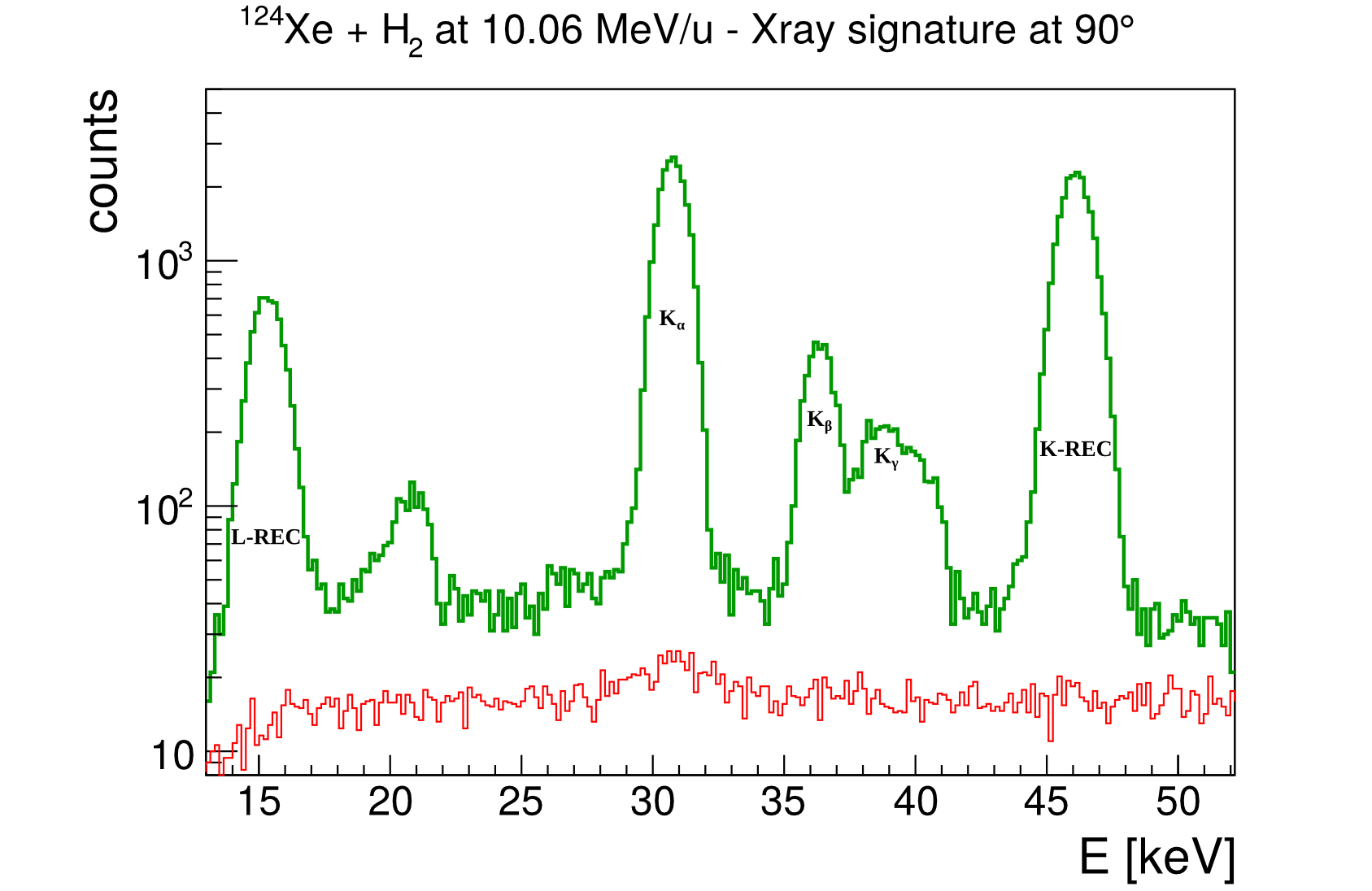
|
| Attachment 2: 124Xe_wScraper_90_backgnd.png
|
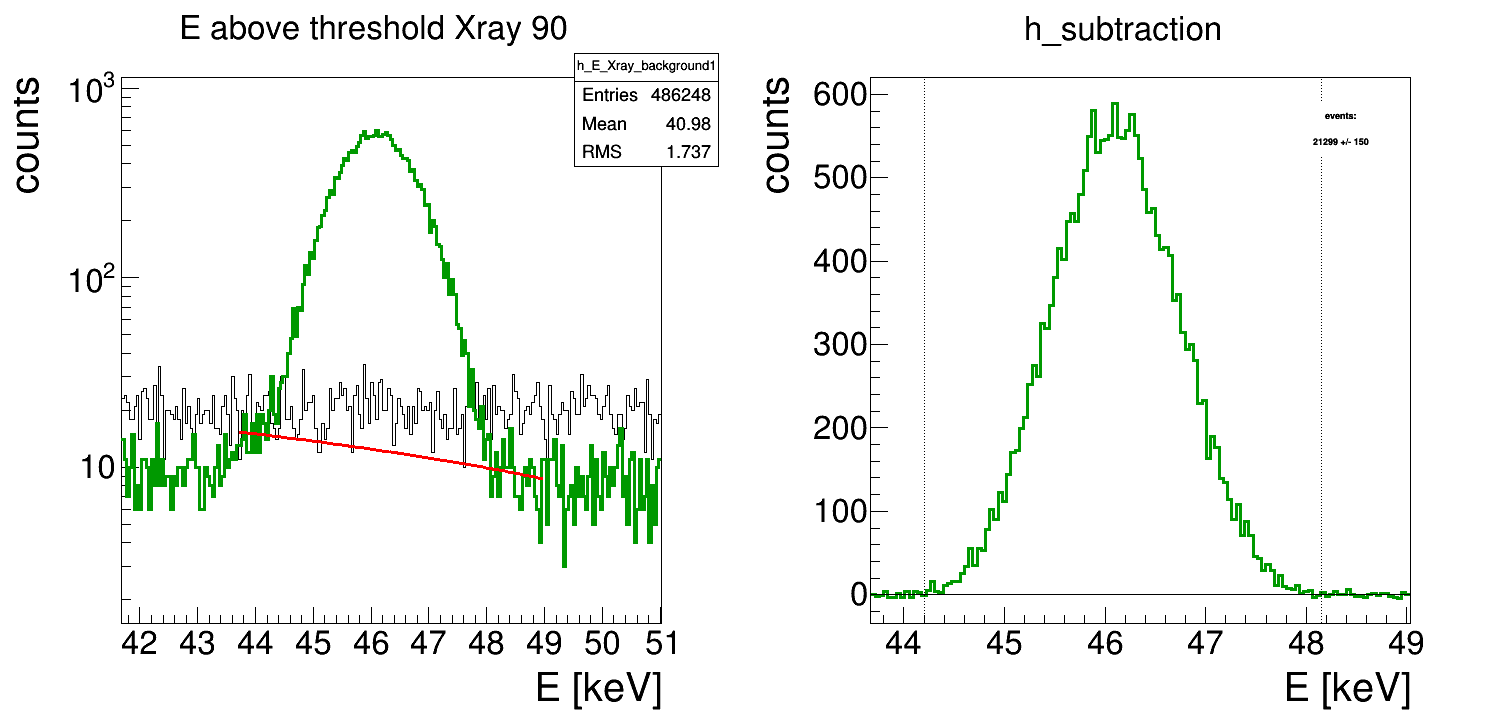
|
| Attachment 3: KREC-pics.zip
|
|
475
|
Wed May 26 19:08:17 2021 |
Ragan, Thanassis | General | Cooler down | 2021 |
We stopped data taking as the electron cooler is down. |